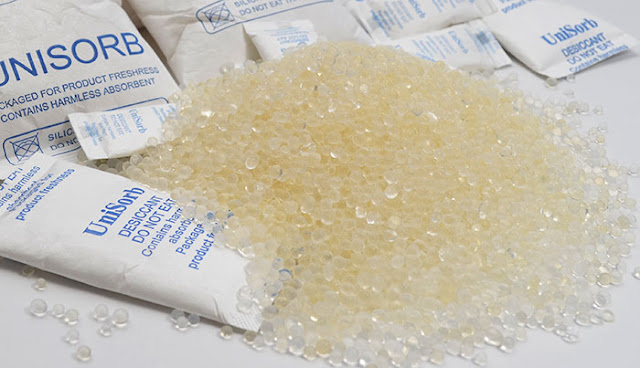Do you remember the first time you found a small package in the box of your new shoes or a food container and wondered what it was? I don't remember exactly, but I do remember wondering what they were. I also remember opening them and putting a few beads on my tongue (I think my dad told me to) to see how they stuck to it. Well, most of the time, these small packages are desiccants made of silica gel used to soak up moisture. However, other types of desiccants can be used for many things. I'll discuss the most important ones in the next article.
Silica Gel
Silica gel is the most
common and well-known type of container
desiccant. A natural mineral
called silicon dioxide (SiO2) is cleaned and made into beads or small granules.
The average size of the pores in silica gel is 24 angstroms, and silica gel
molecules stick to water molecules very well. It can take in water at
temperatures as high as 220°F (105°C). When the temperature goes above 100°F,
the water absorption rate will slow, but it will still work.
Silica gel works best
at room temperature and high humidity (60–90% RH). It will lower the relative
humidity in a container to about 40% RH. It is used a lot in food and medicine
because it is the only desiccant that the FDA has approved for direct contact
with these things.
Silica gel desiccant
has pores of many different sizes, so it can absorb more than just water. It
can also absorb alcohols, aromatics, ammonia, olefins, diolefins, and paraffin.
Activated Carbon
Activated carbon, also
called "activated charcoal," is different from regular charcoal
because it has been "activated" and does not contain harmful fossil
fuels. Its surface area grows a lot during the activation process, giving it
better absorbability.
Activated carbon can
soak up pollutants, poisons, or chemical spills when used in agriculture. It
can be used to treat infections, colic, diarrhea, open wounds, spiders, bees,
ants, scorpion bites, and food poisoning. It can also treat a drug overdose,
gas, ulcers caused by diabetes, heartburn, and indigestion.
Because it can absorb
so much, activated carbon is also used to filter water and air. It will soak up
gases and smells, like those from plastic, cigarette smoke, furniture glue,
carpet smells, bacteria, and viruses. Activated charcoal can also remove
harmful things like chlorine, copper, and carbohydrates from water.
Molecular Sieve
Molecular sieves are
porous synthetic desiccants that attract water molecules very strongly.
Compared to other desiccants, the molecular sieve structure stands out because
the size of the holes in the crystal lattice structure is all the same.
Controlling the size
of the pores on the molecular sieve particles is part of the manufacturing
process. This lets you choose a product that can absorb water but not most
other molecules, such as volatile organics that might be in the package, or one
that can absorb both water and a wide range of molecules.
A molecular sieve can
hold water at temperatures above 450°F (230°C), and because it likes water so
much, it can bring the relative humidity in packages down to as low as 10% RH.
Many different types
of desiccant packs are used for different things, but this article should have
given you an idea of the most important ones. Before using any of them, you
should ask your desiccant provider for more information to be safe.
We recommend you to
get in touch with protective packaging company like Britwrap to buy best desiccants.

Comments
Post a Comment